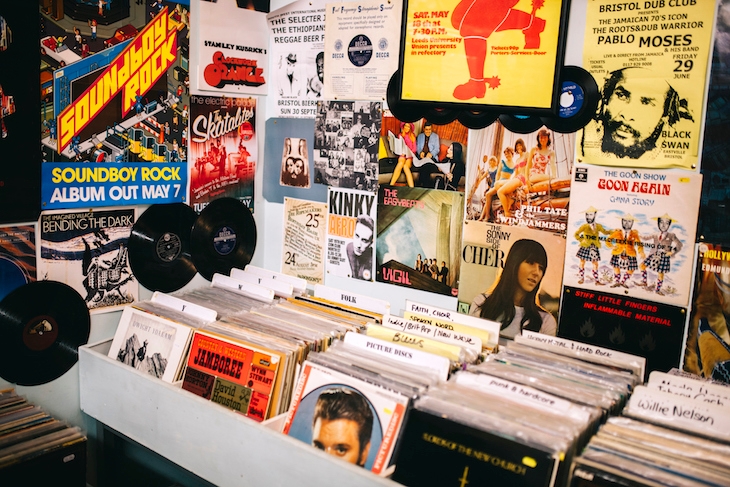Listen closely, among the shelves of the last remaining music shops, in student dorm rooms and amid the flat whites and reclaimed wood of certain coffee shops, and you’ll hear a sound that many thought long banished. Check out the steadily rising sales figures of the past few years and there’s little doubt: the vinyl record is making a comeback. With it comes the return of another sound, like some po-faced, bearded handmaiden: the whine of the vinyl bore.
It is three decades since 12-inch PVC discs were the dominant means of access to music, but for some the format never died and analogue will always offer a purer, more true-to-life audio reproduction. Listen up and you’ll hear them jabbering insistently about ‘warmth’, ‘punch’ and ‘high fidelity’.
The analogue-digital debate is as old as digital recording itself. But few then — and fewer now — recognise that since its inception, the terms of that debate have echoed a much earlier one. As Greg Milner recognised, in his 2009 history of sound recording, Perfecting Sound Forever, the disputes between acoustic recording and electric were the analogue vs digital of the Edison era. It pitched the supposedly more direct, unmediated presence of the phonograph’s mechanical recording process against the electric microphones and amplification that produced what some — including Edison himself — would decry as a mere ‘volume fad’.
But the electrification of sound proved to be no fad. And listening to two different recordings of the same symphony, through a set of headphones slung from a hook near the start of the British Library’s current exhibition, it’s easy to see why. More ‘real’, more ‘direct’ it may be, but the acoustic process on display in a recording of the Großes Odeon-Streich-Orchester in 1911 clearly lacks the tonal depth and dynamic range of the Royal Philharmonic Orchestra under Felix Weingartner recorded electrically 15 years later. No contest. The ‘artificial’ enhancement just sounds better.
Listen, on display in the Library’s Entrance Hall gallery, charts 140 years of sound recording, from Edison’s invention of the phonograph in 1877 to the present day’s streaming audio and portable digital players. The exhibition may be small in comparison to the blockbuster Harry Potter show on the ground floor, but its vitrines are jam-packed with the embalmed corpses of so many dead media, a near century and a half of audio curiosities: from wax cylinders and little dolls’ house discs, brightly coloured ‘playable stamps’ from Bhutan, and record-your-own souvenir records, all the way up to more recent missteps in format history, like the minidisc player and portable tape machine. Each of these is fascinating in its own way and speaks volumes about the place of sound in the everyday life of other eras. But the real pleasure of this show comes from following its titular injunction to grab a pair of earphones and listen.
Walking up to the exhibition from the library’s main entrance you are immediately confronted with this demand in foot-high block capitals. Look closely and you’ll see that these six letters are not embossed on their chipboard wall but engraved into it, revealing a dense thicket of fibres within, as if to suggest that the simple act of listening could strip away the glossy surface sheen of contemporary recording technologies to uncover myriad coarse textures.
Whether listening to the first dub reggae record or the soundscape of Vancouver harbour, the biscuity crackle of old media is inescapable — and in some cases, like the prehistoric (acoustically speaking) trace of Édouard-Léon Scott de Martinville singing ‘Au clair de la lune’ into his phonautograph in 1860, the noise threatens to completely overwhelm the putative signal. Digital formats, with their perfect, crisp silences, their smooth sonic surfaces, erase these traces and in the process erase their own production history. Presenting itself as a kind of pure, unmediated signal, digital, truly, is the format that is both there and not there. That might be why the exhibition’s timeline offers no recordings from after the coming of digital at the start of the 1980s.
Listen is part of the British Library’s ongoing campaign to ‘Save Our Sounds’. When I met the BL sound archive’s Will Prentice in June 2015, he showed me many more extinct formats than the ones on display here: dictabelts and wire recorders, ADATs and sound mirrors. There are around seven million recordings in the collection, bearing a century’s continuous listening. As machines and expertise keep dying, Prentice predicted just 15 years left to preserve them. But it’s not only the recordings themselves that deserve preservation. As the present exhibition makes clear, sometimes the noise — with or without artificial enhancements — can be as significant as the signal.






Comments